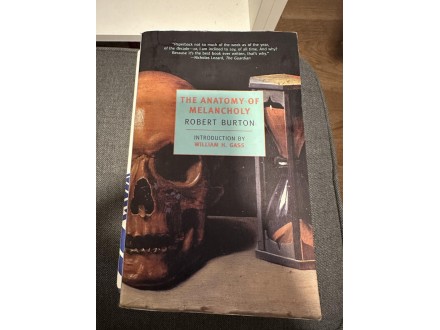Robert Burton - Anatomy of Melancholy
| Cena: |
| Želi ovaj predmet: | 10 |
| Stanje: | Polovan bez oštećenja |
| Garancija: | Ne |
| Isporuka: | CC paket (Pošta) Post Express |
| Plaćanje: | Tekući račun (pre slanja) |
| Grad: |
Beograd-Voždovac, Beograd-Voždovac |
ISBN: Ostalo
Godina izdanja: -
Jezik: Engleski
Autor: Strani
Skoro kao nova.
The Anatomy of Melancholy (full title: The Anatomy of Melancholy, What it is: With all the Kinds, Causes, Symptomes, Prognostickes, and Several Cures of it. In Three Maine Partitions with their several Sections, Members, and Subsections. Philosophically, Medicinally, Historically, Opened and Cut Up) is a book by Robert Burton, first published in 1621,[1] but republished five more times over the next seventeen years with massive alterations and expansions.
On its surface, the book is presented as a medical textbook in which Burton applies his vast and varied learning, in the scholastic manner, to the subject of melancholia (or clinical depression). Although presented as a medical text, The Anatomy of Melancholy is as much a sui generis (unique) work of literature as it is a scientific or philosophical text, as Burton covers far more than the titular subject. Anatomy uses melancholy as a lens through which all human emotion and thought may be scrutinized, and virtually the entire contents of a 17th-century library are marshalled into service of this goal.[2] It is encyclopedic in its range and reference.
In his satirical preface to the reader, Burton`s persona and pseudonym `Democritus Junior` explains, `I write of melancholy by being busy to avoid melancholy.` This is characteristic of the author`s style, which often supersedes the book`s strengths as a medical text or historical document as its main source of appeal to admirers. Both satirical and serious in tone, the Anatomy is `vitalized by [Burton`s] pervading humour`,[3] and Burton`s digressive and inclusive style, often verging on a stream of consciousness, consistently informs and animates the text.[citation needed] In addition to the author`s techniques, the Anatomy`s vast breadth – addressing topics such as digestion, goblins, the geography of America, and others[2] – make it a valuable contribution to multiple disciplines.
Publication
edit
Burton was an obsessive editor of his own work, publishing five revised and expanded editions of The Anatomy of Melancholy during his lifetime. It has often been out of print, particularly between 1676 and 1800.[4] Because no original manuscript of the Anatomy has survived, later reprints have drawn more or less faithfully from the editions published during Burton`s life.[5] Early editions have entered the public domain, with several available from online sources such as Project Gutenberg. In recent decades, increased interest in the book, combined with its public domain status, has resulted in new print editions, most recently a 2001 reprinting of the 1932 edition by The New York Review of Books under its NYRB Classics imprint (ISBN 0-940322-66-8).[2]
Admirers of The Anatomy of Melancholy range from Samuel Johnson,[9] Holbrook Jackson (whose Anatomy of Bibliomania [1930] was based on the style and presentation), George Armstrong Custer, Charles Lamb and John Keats (who said it was his favourite book) to Northrop Frye, Stanley Fish, Anthony Powell, Philip Pullman,[10] Cy Twombly, Jorge Luis Borges (who used a quote as an epigraph to his story `The Library of Babel`), O. Henry (William Sidney Porter), Amalia Lund, William Gass (who wrote the Introduction to the NYRB Classics 2001 reprint), Nick Cave, Samuel Beckett[11] and Jacques Barzun (who sees it anticipating 20th-century psychiatry).[12] According to The Guardian literary critic Nick Lezard, the Anatomy `survives among the cognoscenti`.[13] Washington Irving quotes from it on the title page of The Sketch Book.
Burton`s solemn tone and his endeavour to prove indisputable facts by weighty quotations were ridiculed by Laurence Sterne in Tristram Shandy.[14][15] Sterne also mocked Burton`s divisions in the titles of his chapters, and parodied his grave and sober account of Cicero`s grief for the death of his daughter Tullia.[14]
Slanje posle uplate na tekući račun.
Izbegavam da saljem kao preporucenu tiskovinu - (1) zato sto knjiga mora sa se umota u papir (i da se pohaba), ne moze u karton i (2) moze da putuje dugo.
CC posiljka - cena 200 din ali postar ne donosi kuci nego se mora u postu. CC koji se donosi na adresu je - 340 din a Postexpress je 350. Kada kupite samo mi napisite koje slanje vam odgovara.
Živim na Trošarini (Voždovac); ako bi vam odgovaralo lično preuzimanje, najbolje da svratite u moj kraj.
Predmet: 76995421













